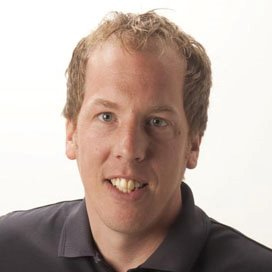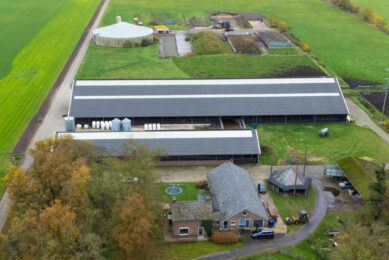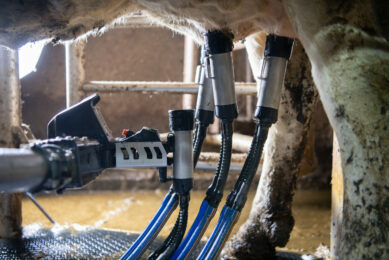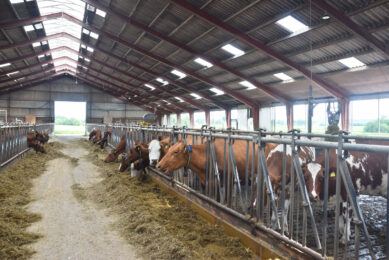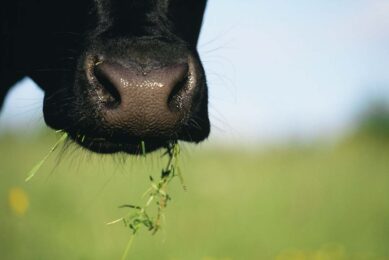Danish dairy farmer: Growth without extra labour
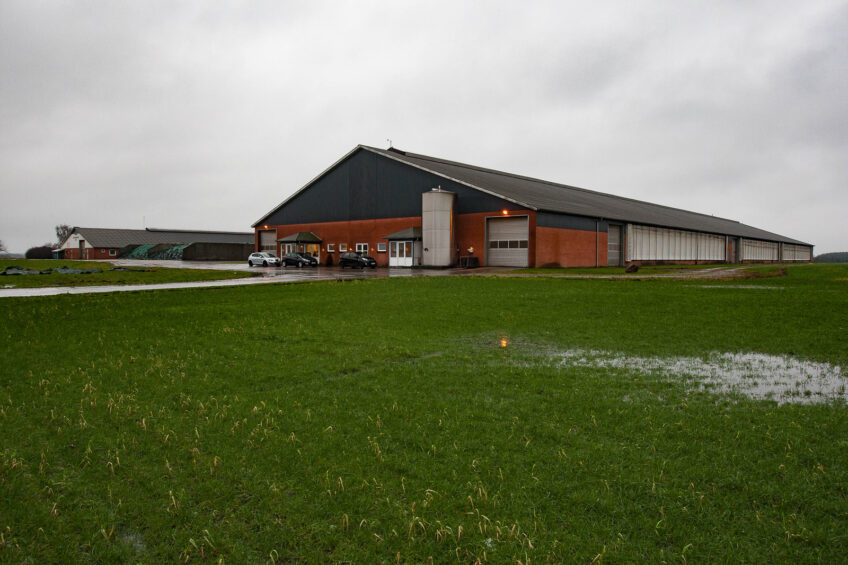
Is it possible to have a dairy farm and still go on a 6 week holiday? Or to survive in the industry when the milk price is only €0.30? Even grow without increasing your manpower or having the banks knock on your door? Danish dairy farmer Gunner Forum tells how he has achieved all of this.
Many dairy farmers only allow themselves a vacation of 1 or 2 weeks a year, preferably not too far away, so it is possible to drive back to the farm quickly in case of emergency. Gunnar Forum is an exception to this rule.
In the 1980s, Forum worked at a dairy farm in New Zealand for a year. It had always been his dream to go back one day to show his wife and children what it is like. A beautiful landscape and a good mentality. In the winter of 1999 he did just that for 6 weeks. “New Zealanders and the Danish are alike in that regard,” the cheerful farmer says. He chiefly sees the trip with his family as a reward for 10 years of hard work and investing in the right employees. Afterwards, he made 2 similar trips. Forum puts a lot of trust in his employees. Not surprisingly, he was awarded the Danish Agricultural Working Environment Award in 2014.

Profile
Company: Sandagergaard, Gunnar Forum (54), his wife and 4 full-time employees manage a dairy farm with 460 Holstein Frisian cows in Skals (Denmark). The company boasts 400 hectares of land, mainly for grass and maize. Forum grows barley on 60 hectares, half of which is used for the company’s own cattle and the other half is sold. The company has 7 Lely A3 milking robots, that together yield an annual production of 6.5 million kilogrammes of milk. 6.1 million kilogrammes go to dairy cooperative Arla, the rest of the milk goes to the calves. In the last 5 months, the average production per cow has increased to 14,187 kilogrammes 3.67% fat and 3.42% protein.
When the bank starts telling you what to do – its over!
The 147 metre deep and 40 metre wide dairy barn is large, but fits well in the open Danish landscape. Peace, quiet and space are what characterise the north of Mid-Jutland (Midtjylland). The colour scheme of the dairy barn, built in 2008, is the typically Scandinavian claret, combined with dark grey at the top. The white stable curtains along the feeding rows are closed. With temperatures around freezing, it is chilly and damp. In the middle of the insulated barn are a total of 7 Lely A3 milking robots.
The last one found its way to the dairy barn last year, after the abolition of the milk quota. A golden buy, it appeared. The production rapidly increased with 800,000 kilogrammes, without expansion of the dairy barn or staff, but only 30 additional dairy cows. Creating a separate group for heifers also helped. One robot serves around 55 heifers, while in the mixed groups there are 65 cows on one robot.
The substantial increase in production provided a good way to decrease costs to around €0.29 per kilogramme of milk. Forum can even cope with the current milk price of €0.30. It is not a luxury, but still a condition for the sustainable future of his company, according to the farmer. “Make sure you are among the best performing companies. It ensures your future.” As soon as the bank tells him what he needs to do, as is the case at many Danish companies at the moment, it is over. “In that
scenario, I don’t want to be a farmer anymore.”
Growth of the farm
Forum and his wife started their dairy farm with 70 cows in 1989, about one kilometre from their current location. They had to work hard and certainly did not think of letting the company grow to its present size. “I really did not have 460 dairy cows in mind back then.” The simplification of the trading in milk quota in the 90s was an important development for Forum’s company. He added to his milk quota on several occasions. The acreage of his land quickly increased as well. Why? “I was young and did not mind the work.” Moreover, he wanted a future for his company and attract qualified staff to be able to leave the farm more often. Forum has succeeded in that aspect, apart from the mentioned vacations. In the first years, Forum worked nearly every weekend. At the moment, he only works every third one. Another important step in the development of his company was the 2008 construction of a new barn for 460 dairy cows at the present location. Enough comfort for both the cows and the employees was a prerequisite. Both seem to have worked out fine. Production skyrockets with 14,000 kilogrammes and people approach Forum regularly to inquire about job opportunities.
High energy feed for high production
Despite all this, it is the simplicity that is striking in this impressive barn; how clean and tidy it looks. There is a hose for cleaning boots at all exits and entrances. Items are cleared away instantly after use and cleaning is part of the daily activities. Otherwise, you do not imagine yourself in a state-of-the-art barn. To reach the current high production, Forum says he feeds very energy rich roughage and concentrates. He feeds a mixed ration (2/3 maize and 1/3 grass), 7 kilogrammes of concentrate per cow every day, 0.25 kilogrammes vegetable fat from palm oil (Bergafat) and 1.5 kilogrammes of soda grain. The cows receive on top of that another 4.5 kilogrammes of concentrate a day in the milking robots.
Barn: Sand use has health benefits for the cows
The 460 cubicles are filled with sand – 1,000 cubic metres are used for this purpose every year, roughly 40 truckloads. The cubicles are cleaned 2 to 3 times a day and layers are added every 3 weeks. This costs around €25 per cow per year, which is more than covered by the savings on animal health costs. These are only €70 per cow every year on average. The two scraper robots, also manufactured by Lely, keep the slatted floors clean. A slide is used to shove manure and sand from the 60 centimetre deep manure pit, after which the material disappears into one of the silos with the aid of a pump. Forum had to remove sand from the silos 3 times in 8 years. That cost him €2,500 each time, but in his opinion, this does not outweigh the many benefits of sand.
Calves
Next to the new dairy barn is the old dairy barn, which is now in use for the young cattle. Right behind it, is a storage building for feed and behind that is the barn for the calves, built in 2011. It is remarkable that the farmer keeps all of his calves at the company for 4 weeks. This stems from an agreement with a fattener that yields €200 for each calf. Of course, feed costs of around €2 per calf per day still need to be deducted. He has 35% of his cows, no heifers, inseminated with Belgian Blue. Calves from these cows yield an additional €100.
Communication with employees
The secret of his success is obviously not the material aspect alone. Forum is a people person. The start of the day is typical. All employees have breakfast in the farmer’s house every day. By doing this, they can easily share information and it contributes to the team spirit among his relatively young staff. Is Forum a natural manager then? No, he can well image the fear many of his colleagues experience having to work with employees they do not know. For this reason, he followed a year and a half long course in 2006 on how to manage a large dairy farm. “I had to learn to better communicate with my employees to keep them motivated. Those kinds of things.” Moreover, Forum finds it costs time to accept that not everything works out the way you want it to.
His employees enjoy freedom and space to try things out. Something they appreciate, seeing that many of them want to start their own companies in the future. At the same time, Forum thinks it is a challenge to show his staff how to get the best results and how to involve them in realising goals. Moreover, he thinks that he can keep on performing well by hiring young employees. However, things in the employee department are not always perfect. A few years ago, he was forced to dismiss a new employee. After the usual training period, he still did not do what was asked of him. An uncomfortable moment for Forum, but necessary to ensure a stable operation.
Employee : Milking ratio
Forum’s employees seem highly motivated. Does he pay them so much more than his colleagues do? “No, I pay them fair wages at the same level as other companies do.” He refers the number of employees he needs to the kilogrammes of milk he produced. Over a million kilogrammes per employee. Too few employees, a thing he was afraid of in the past and partly explains the choice for milking robots, is unthinkable for him. “Realising an optimal production can only be done with enough people.” Employees are one of the last expenses Forum would consider cutting. Which does not imply he is in trouble. Up until now he has always made a profit, despite difficult years. In a good year, such as 2014, extra payments on the mortgage are a priority. This should form a buffer for possible difficult times. Despite sizeable investments, he never financed more than €1.50 per kilogramme of milk. In the budgeting for this year, he calculated that the milk price would stay at the same level. Of course, he hopes prices will increase after the summer. He is certain prices will increase over time. “When prices decrease too much, some dairy farmers have to stop. That will increase prices.”
Join 13,000+ subscribers
Subscribe to our newsletter to stay updated about all the need-to-know content in the dairy sector, two times a week.







